Piano Lessons [Sintra]
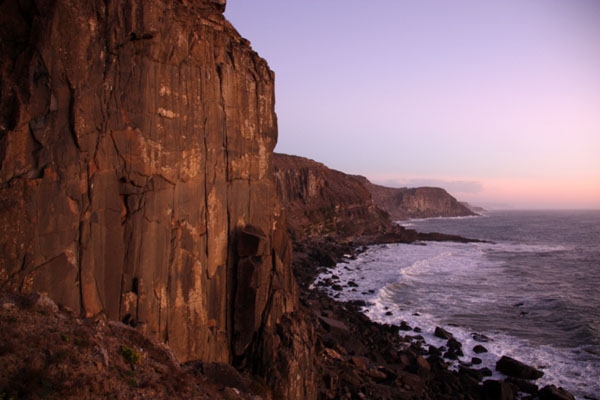

O material magmático da Lomba dos Pianos corresponde a uma
soleira (filão subhorizontal que acompanha as camadas
sedimentares), com cerca de 3 Km de extensão e 17 m de espessura.
Esta rocha formou-se há cerca de 72 milhões de anos,quando o
magma intrudiu nas rochas calcárias que já existiam nesta região
(da idade Cretácica com camadas dispostas aproximadamente na
horizontal), durante o episódio que levou à formação do
Complexo Vulcânico de Lisboa.
O nome de Lomba dos Pianos tem origem na disjunção
prismática, que aqui é particularmente evidente, lembrando os
órgãos de tubos, presentes em algumas igrejas. A disjunção
prismática aqui é manifestamente perpendicular à superfície de
arrefecimento (limites da soleira).
Uma antiga pedreira de inertes, entretanto desactivada,
desgastou artificialmente parte da parede rochosa expondo o
fenómeno descrito de uma forma muito evidente. No ponto zero, e
olhando para Este, e possível verificar, no topo da parede as
camadas sedimentares, mais antigas. Logo por baixo é visível a
rocha ígnea correspondente a uma soleira formada por intrusão
do material magmático.
Identificação das Rochas Ígneas
As rochas Ígneas constituem um dos três principais tipos de
rochas (as outras são as sedementárias e as metamórficas). São
formadas através do arrefecimento e solidificação do magma ou lava.
Podem formar-se com ou sem cristalização, debaixo das superfície,
como rochas plutónicas intrusivas, ou na superfície como rochas
vulcânicas extrusivas. O magma pode ter origem no derretimento de
rochas já existente na crosta ou manto terrestre, causado por um,
ou mais dos seguintes três processos: aumento da temperatura,
decréscimo da pressão, ou alteração da composição.
Existem mais de 700 tipos de rochas ígneas identificadas,
tendoa maioria sido formada abaixo da
superfície terrestre. Possuem propriedades diversas dependendo da
sua composição e da forma como foram formadas. A identificação das
rochas ígneas pode ser efectuada através da determinação da sua
composição e da sua textura.
Composição / Cor
A composição
das rochas ígneas é correctamente identificada através da sua
composição química. No entanto, este procedimento requer aparelhos
e manterial químico, normalmente não disponível no campo.
Felizmente a determinação exacta da composição química da rocha
poderá não ser necessária. A cor da rocha é por vezes um excelente
indicador da sua composição, e pode ser usada para identificar a
composição da maioria das rochas ígneas.
As cores claras, incluindo o branco, cinzento claro, bege e rosa,
indicam um composição félsica, portanto rica em sílica.
As cores escuras, como o preto e castanho escuro, indicam uma
composição máfica, ou ultramáfica, pobre em sílica, mas rica em
ferro e magnésio.
As composições mistas possuem cores intermédias, cinzento ou partes
iguais de material claro e escuro.
É necessária atenção porque embora uma rocha ígnea possa ter uma
composição félsica, ainda assim pode ter alguns minerais escuros, e
igualmente uma rocha de composição máfica poderá ter alguns
minerais de cor clara.
No entanto há algumas excepções a estas regras, as duas mais
importantes são a Obsidiana e o Dunito.
A Obsidiana é o vidro vulcânico com origem na lava expelida, que é
félsica na sua composição, embora possua uma cor muito escura
(castanho escuro a preto).
O Dunito tem composição ultramáfica embora seja de côr verde-maçã a
verde amarelado, sendo composta maioritariamente por olivina, que
contém ferro e magnésio.
Textura
A textura das rochas ígneas não se refere à sua rugosidade, ou
suavidade, mas sim, ao tamanho dos cristais que as
constituem.
Textura Fanerítica
A rocha de textura fanerítica é composta por cristais de
grande dimensão, claramente visíveis a olho nú. As rochas são
constítuidas por cristais de dimensão variável entre 0,5mm até
vários centímetros. A matriz da rocha não contém outros
cristais mais finos.
Esta textura tem origem no arrefecimento do magma de forma lenta em
profundidade (rochas plutónicas).
Textura Afanítica
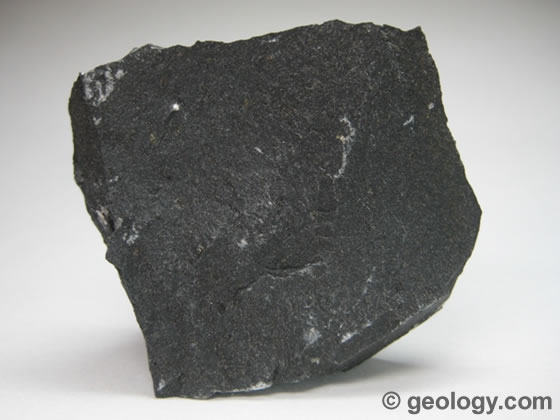 A textura Afanítica consiste
em cristais de pequenas dimensões, não visíveis a olho nu, sem
auxílio de uma lupa. A rocha é constítuida por pequenos cristais,
em geral com menos de 0,5mm de tamanho.
A textura Afanítica consiste
em cristais de pequenas dimensões, não visíveis a olho nu, sem
auxílio de uma lupa. A rocha é constítuida por pequenos cristais,
em geral com menos de 0,5mm de tamanho.
Esta textura resulta do rápido arrefecimento do magma.
Textura Porfírica
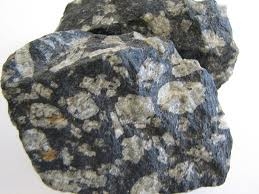 As rochas de textura porfírica são normalmente
constítuidas por dois cristais com dimensões bastante
diferentes.
As rochas de textura porfírica são normalmente
constítuidas por dois cristais com dimensões bastante
diferentes.
Os cristais maiores são normalmente designados por fenocristais, e
os de pequeníssima dimensão como matriz ou massa compacta.
As rochas porfíricas foram sujeitas a duas fases de arrefecimento,
uma em profundidade, onde os cristais de maior dimensão se
formaram, e outra na superfície ou perto desta, onde se forma a
matriz.
Textura Vítrea
 A rochas com textura vítrea não contêm cristais,
resultando de um arrefecimento muito rápido, que impede a
cristalização dos minerais.
A rochas com textura vítrea não contêm cristais,
resultando de um arrefecimento muito rápido, que impede a
cristalização dos minerais.
São formadas quando o magma entra em contacto com materiais de
temperatura muito menor, perto da superfície terrestre.
O Vidro vulcânico puro é chamado Obsdiana.
Textura Vesicular
 As rochas de textura vesicular possuem
orifícios ou cavidades na sua estrutura. São formadas quando ocorre
libertação de gases na forma de bolhas, e que posteriormente ficam
retidas pela consolidação do próprio magma.
As rochas de textura vesicular possuem
orifícios ou cavidades na sua estrutura. São formadas quando ocorre
libertação de gases na forma de bolhas, e que posteriormente ficam
retidas pela consolidação do próprio magma.
A pedra-pomes é um bom exemplo desta textura.
Textura Fragmental
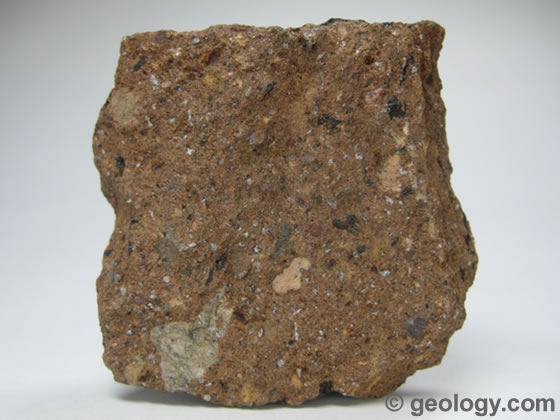 A Textura fragmental corresponde às rochas piroclásticas,
expelidas para a atmosfera durante a erupção vulcânica. São
compostas por numerosos grãos ou fragmentos agregados pelo
aquecimento provocado pela erupção vulcânica. Por vezes são
visíveis pedaços de vidro na composição deste tipo de rocha.
A Textura fragmental corresponde às rochas piroclásticas,
expelidas para a atmosfera durante a erupção vulcânica. São
compostas por numerosos grãos ou fragmentos agregados pelo
aquecimento provocado pela erupção vulcânica. Por vezes são
visíveis pedaços de vidro na composição deste tipo de rocha.
Earthcache
Como chegar às coordenadas da cache:
- Estacionar o carro perto da cancela da antiga pedreira. A
partir daí o acesso é pedreste.
- O acesso pedestre é permitido (validado com as pessoas que
habitam os edíficios da antiga mina). O local é também utilizado
por praticantes de escalada.
- Caminhar no sentido do mar, deixando as casas à sua
direita.
Para obter um found nesta eartcache deverá responder às seguintes
questões:
- Qual a altura da soleira, vista a partir do ponto zero,
olhando para Este?
- Utilizando a chave cor/textura fornecida em baixo
identifique o tipo de rocha ígnea presente nesta
soleira.
- Na sua opinião qual foi o ritmo de arrefecimento do magma
neste caso?
- Que outro fenómeno é observável que confirma o tipo de
arrefecimento?
- (Opcional) Por favor coloque uma foto do local no seu log,
as melhores fotografias serão incluídas na página da
cache.
Envie as respostas pedidas através do nosso perfil de geocaching.
Os logs efectuados sem envio das respostas serão apagados.

Lomba dos Pianos
Lomba dos Pianos is a magmatic sill with about 3km long and
17m thick. This igneous rock was formed about 72 million years ago,
when magma intruded the sedimentary limestone (Cretaceous age with
horizontal layers), during the formation of the Volcanic complex of
Lisbon.
The name Lomba dos Pianos has origin in the prismatic disjunction
which is easily observed in this location, reminding organ tubes.
The prismatic disjunction is clearly perpendicular to the cooling
surface.
An deactived quarry, exposed the igneous rock and the described
phenomena is easily observed. On the given coordinates, looking
east, one can easily see the sedimentary layers, of older age, and
just beneath the igneous rock, corresponding to a sill formed by
the intrusion of the magma.
Igneous Rock Identification
Igneous rock (derived from the Latin word igneus meaning of
fire) is one of the three main rock types, the others being
sedimentary and metamorphic rock. Igneous rock is formed through
the cooling and solidification of magma or lava. Igneous rock may
form with or without crystallization, either below the surface as
intrusive (plutonic) rocks or on the surface as extrusive
(volcanic) rocks. This magma can be derived from partial melts of
pre-existing rocks in either a planet's mantle or crust. Typically,
the melting is caused by one or more of three processes: an
increase in temperature, a decrease in pressure, or a change in
composition. Over 700 types of igneous rocks have been described,
most of them having formed beneath the surface of Earth's crust.
These have diverse properties, depending on their composition and
how they were formed. Igneous rocks can be identified by the
determination of the composition and texture of the
rock.
Composition / Color
Composition of igneous rocks is properly identified by
determination of the rock's chemical composition. This, however,
requires chemical equipment and apparatus that is usually
unavailable in the field. Fortunately determination of the exact
chemical composition is not necessary. Color is often an indicator
of the composition of a rock or mineral and can be effectively used
to identify the composition of most igneous rocks.
Light colors, including white, light gray, tan and pink, indicate
a felsic composition. Felsic compositions are rich in
silica (SiO2).
Dark colors, such as black and dark brown, indicate amafic or
ultramafic composition. Mafic compositions are poor in
silica, but rich in iron (Fe) and magnesium (Mg).
Intermediate compositions have an intermediate color, often
gray or consisting of equal parts of dark and light mineral .
Beware that even though an igneous rock may have
a felsiccomposition (light color), the rock can contain dark
colored minerals. Mafic rocks may contain light colored
minerals as well. As mentioned above, the composition of most
igneous rocks can be identified using this system, formally known
as the Color Index.
However, there are exceptions. The two most notable
are obsidian and dunite. Obsidian is
volcanic glass which erupts as a lava flow.
Most obsidian is felsic in composition, yet
typically it will have a very dark color (dark brown to
black).
Dunite has an ultramafic composition yet is apple
green to yellowish green in color. Dunite is composed
almost entirely of the mineral olivine which usually contains both
iron and magnesium.
Texture
The texture of an igneous rock does not refer
to the roughness or smoothness of the surface. Textures are based
primarily on crystal size.
Phaneritic Texture
Phaneritic textured rocks are comprised of large crystals that
are clearly visible to the eye with or without a hand
lensor binocular microscope. The entire rock is made up
of large crystals, which are generally 1/2 mm to several
centimeters in size; no fine matrix material is
present.
This texture forms by slow cooling of magma deep underground in the
plutonic environment.
Aphanitic Texture

Aphanitic texture consists
of small crystals that cannot be seen by the eye without hand lens.
The entire rock is made up of small crystals,
which are generally less than 1/2 mm in
size.
This texture results from rapid cooling in volcanic or
hypabyssal (shallow subsurface)
environments.
Porphyritic Texture
 Porphyritic texture is really a subtype, but usage of
the term often confuses the beginner. Porphyritic rocks are
composed of at least two minerals having a conspicuous (large)
difference in grain size. The larger grains are termed phenocrysts
and the finer grains either matrix or groundmass (see the drawing
below and image to the left).
Porphyritic texture is really a subtype, but usage of
the term often confuses the beginner. Porphyritic rocks are
composed of at least two minerals having a conspicuous (large)
difference in grain size. The larger grains are termed phenocrysts
and the finer grains either matrix or groundmass (see the drawing
below and image to the left).
Porphyritic rocks are thought to have undergone two stages of
cooling; one at depth where the larger phenocrysts formed and a
second at or near the surface where the matrix grains
crystallized.
Glassy Texture
 Glassy textured igneous rocks are non-crystalline
meaning the rock contains no mineral grains.
Glassy textured igneous rocks are non-crystalline
meaning the rock contains no mineral grains.
Glass results from cooling that is so fast that minerals do not
have a chance to crystallize. This may happen when magma or lava
comes into quick contact with much cooler materials near the
Earth's surface.
Pure volcanic glass is known as obsidian
Vesicular Texture
 This term refers to vesicles (holes,
pores, or cavities) within the igneous rock. Vesicles are the
result of gas expansion (bubbles), which often occurs during
volcanic eruptions. Pumice and scoria are common types of vesicular
rocks.
This term refers to vesicles (holes,
pores, or cavities) within the igneous rock. Vesicles are the
result of gas expansion (bubbles), which often occurs during
volcanic eruptions. Pumice and scoria are common types of vesicular
rocks.
Fragmental Texture
 Found on pyroclastic rocks, those blown out into the
atmosphere during violent volcanic eruptiions. These rocks are
collectively termed fragmental. If you examine a fragmental
volcanic rock closely you can see why. You will note that it is
comprised of numerous grains or fragments that have been welded
together by the heat of volcanic eruption. If you run your fingers
over the rock it will often feel grainy like sandpaper or a
sedimentary rock. You might also spot shards of glass embedded in
the rock. The terminology for fragmental rocks is voluminous, but
most are simply identified as "tuff".
Found on pyroclastic rocks, those blown out into the
atmosphere during violent volcanic eruptiions. These rocks are
collectively termed fragmental. If you examine a fragmental
volcanic rock closely you can see why. You will note that it is
comprised of numerous grains or fragments that have been welded
together by the heat of volcanic eruption. If you run your fingers
over the rock it will often feel grainy like sandpaper or a
sedimentary rock. You might also spot shards of glass embedded in
the rock. The terminology for fragmental rocks is voluminous, but
most are simply identified as "tuff".
Earthcache
How to get to the earthcache coordinates:
- You should park your car near the old quarry gate and walk
from there.
- The access is authorized as long as you go on foot (the
place is also used for rock climbing).
- You should walk towards the sea passing by the house on
its left side.
To claim a find in this eartcache you should answer the following
questions:
- What is the height of the sill, seen from the given
coordinates looking east?
- Using the Color/Texture identification key identify
the igneous rock of the sill.
- In your oppinion what was the pace of the magma
cooling?
- What other phenonema can be seen that confirms the cooling
rate?
- (Optional) Please post a picture on your log, best
pictures will be promoted to the cache page.
Send the answers through our geocaching profile. Found logs without
answers will be deleted.
Chave de Identificação através da Cor e
Textura
A seguinte tabela pode ser utilizada no campo para a
classificação das rochas ígneas, de uma forma simples.
Color/Texture Identification Key
The following key can be used in the field to classify igneous
rocks in a simple way.
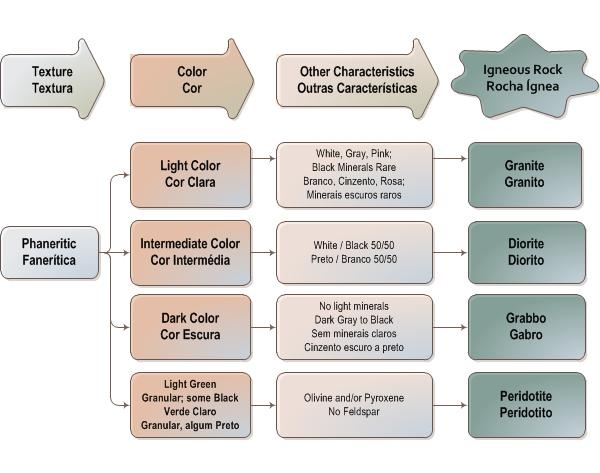
Sources:
Dave Jessey, Don Tarman, Project Alert NASA/CSU
Lynn S. Fichter, Department of Geology and Environmental Science
James Madison University, USA
Richard Harwood, Black Hawk College
Images:
geology.com
